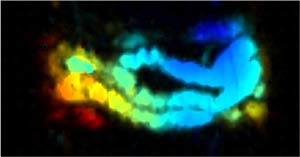
Image using nanojuice inside the intestine of a mouse; Courtesy: U of Buffalo research & Jonathan Lovell, PhD
A few weeks ago this topic came across my desk. Research on something called nanojuice and its link to celiac. I had never heard of this before.
The news release was not as quick to link nanojuice as a new way to diagnose celiac disease, it sort of floated the possibility out there. A follow up article in Nature World News clearly stated the link however. So I decided to look into it a bit.
Nanojuice works like this. “Nanoparticles are suspended in liquid to form ‘nanojuice’ that patients would drink,” the news release says. Jonathan Lovell, PhD, University of Buffalo Assistant Professor and corresponding author on this study took the explanation from there when I interviewed him via email earlier this month. “By using non-invasive imaging techniques, the doctor will be able to visualize the intestine in real-time from outside the body.”
The news release considered it as a potential alternative to the current process of patients taking barium and then being x-rayed, getting an MRI or ultrasound to figure out what is going on inside.
As folks who have been tested for and/or diagnosed with celiac disease, you know the endoscopy and biopsy is considered the gold standard to determine the autoimmune disorder. So how does this work for us?
“There are several reasons why this technique has a lot of potential for diagnosing celiac,” Lovell said. “For instance, we can make 2-3 different colored nanojuices all containing nanoparticles with different surface properties. It is likely that these would interact with the gut differently in a patient with celiac compared to a healthy intestine. But we need to test this hypothesis,” Lovell said. The technology, according to Lovell, has not yet been tried for diagnosing chronic gut diseases in animals, let alone humans.
So can they see the damaged villi during this technique? Lovell says no, they have not been able to see individual villi yet…but it is something they are aware of. “In theory, [the technique] may be useful to better understand how the intestine of celiac works with respect to peristalsis [muscular contractions of the intestine] and segmentation and there may be characteristic features about these,” Lovell said.
Where will nanojuice take us in detecting celiac? That remains to be seen. But if it eventually proves to be good at diagnosing celiac, it could be a less-invasive option for patients. Researchers hope to eventually get human trials for nanojuice.
*Click here to read the research published in Nature Nanotechnology journal
Tags: barium, biopsy, celiac, detection, diagnosis, disease, endoscopy, free, gluten, gluten-free, nanojuice



Leave a Reply